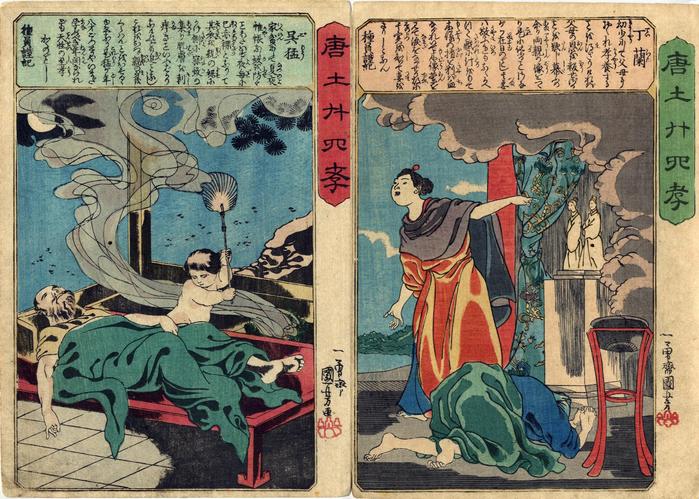Utagawa Kuniyoshi (歌川国芳) (artist 11/15/1797 – 03/05/1861)
Go Mō (呉猛) and Tei Ran (丁蘭) from the series The Twenty-four Chinese Paragons of Filial Piety (Morokoshi nijūshi-kō - 唐土廾四孝)
1848
13.5 in x 9.5 in (Overall dimensions) Signed: Ichiyūsai Kuniyoshi ga
一勇斎国芳画
Artist's seal: toshidama
Inscription: Ryūkatei Tanekazu
Kuniyoshi Project
Museum für angewandte Kunst, Vienna - right panel
Museum für angewandte Kunst, Vienna - left panel
Tokyo Metropolitan Library - left panel
Museum of Fine Arts, Boston - left panel
Museum of Fine Arts, Boston - lright panel
Tokyo Metropolitan Library - right panel
Musées Royaux d'Art et d'Histoire (via Ritsumeikan University) - right panel only - trimmed
Musées Royaux d'Art et d'Histoire (via Ritsumeikan University) - left panel only -trimmed
Art Institute of Chicago - left panel only
Art Institute of Chicago - right panel
Museum für Ostasiatische Kunst, Köln - the right-hand panel Below is R. Keller Kimbrough's translation of an early edition of the Nijūshikō. It does not specifically apply to these Kuniyoshi prints except in the most general terms.
[3] Tei Ran 丁蘭 (Ding Lan)
Carving wood, he makes it his father and mother;Tei Ran was from a place called Yaō in Kadai. He lost his mother at the age of fifteen, and because he long mourned the separation, he had a wooden statue carved in her likeness, which he served as if it were a living person. One night Tei Ran’s wife burned the statue’s face with a flame, whereupon [the wife] broke out in blisters seeping pus and blood. After two days, the hair on the wife’s head fell out as if it had been cut with a sword. In her surprise, she apologized for what she had done. Tei Ran was amazed, and he moved the statue out onto the street. He had his wife pay penance for three years. Then, on a certain night, with the sound of a storm, the statue moved back inside the house of its own accord. From that time on, Tei Ran and his wife would consult the statue about even the most trivial matters, or so people say. There are few who have performed such filial service to cause such strange things to occur!
every day their expressions shift anew.
Children and nieces all tell the tale,
and word of his filial piety quickly spreads.
Kimbrough added that “The poem speaks of two carved statues, but the story, which differs radically from the one in the source text by Guo Jujing, speaks of only one. Yaō 野王 (Yewang) and Kadai 河内 (Henei) are places in present-day Henan 河南 Province. I follow Ōshima in supposing that it is Tei Ran’s wife who breaks out in blisters. However, insofar as the subject of the clause is unstated, and blistering is a natural result of a burn, it is possible that it is the statue that is injured.”
[20] Go Mō 呉猛 (Wu Meng)
Without a net in the summer night,“At the age of eight, Go Mō was a filial child. Because his family was poor, they had none of the things that they wanted. Thus, although the summer arrived, they had no mosquito net. Go Mō thought to himself that if he took off his robe, put it on his parents, and then lay naked so that the mosquitoes would bite him, then they would bite only him and he could spare his parents. For this reason he always lay naked through the night, allowing the mosquitoes to bite him. He served his parents by keeping the mosquitoes away. For a child to be so filial is truly amazing!”
he never drives the many mosquitoes away.
Letting them feast as they please on his fat and blood,
he keeps them from his parents’ room.
****
The text below was composed by Ryūkatei Tanekazu (柳下亭種員: 1807-58).
The text on the panel on the right reads: 丁蘭(ていらん) 幼少(やうしやう)にして父母におくれ孝養(かうやう)することを得(え)ざりければ父母の恩(おん)を報(ほう)ぜざることを歎(たん)じ慕(した)ふの余(あま)り両親(りやうしん)の像(ぞう)をつくり是(これ)に仕(つか)ふることさながら在日(いますひ)のごとし其妻(つま)は敬(うやま)ふ色(いろ)もなくかへつて戯(たわふれ)に針(はり)をもて木像(もくぞう)の指(ゆび)を刺(させ)ば血(ち)ながれいで木像(もくぞう)蘭(らん)を見て涙(なみだ)をながせり故(ゆゑ)に其実(そのじつ)を知(し)つて妻(つま)をさりしとなん 種員謹記
The book entitled The Twenty-four Paragons of Filial Piety was written by the Chinese scholar Guo Jujing during the Yuan Dynasty. His pen name was Yizi, and he is known in Japan as Kaku Kyokei. The book recounts the self-sacrificing behavior of twenty-four sons and daughters who go to extreme lengths to honor their parents, stepparents, grandparents, and in-laws. Many of the images in this series appear Western in style, rather than Japanese, and were probably copied from Italian prints. The prints in this edition appear to have been printed two per ōban sheet (about 9.5 x 13.5 inches) and folded to chūban pages (about 9.5 x 6.75 inches). The were once bound together in an album.
Japanese name: Gomô
Chinese name: Wu Mêng
Eight year old Gomô would let himself be bitten by mosquitoes so as to spare his sleeping parents. Here he is fanning mosquitoes away from his sleeping father.
Robinson: S60.23
Japanese name: Teiran
Chinese name: Ting Lan
Teiran carved wooden images of his parents to which he regularly paid his respects. Returning home one day he found a frown on the face of the statue of his mother and learned that his wife had insulted his mother’s memory. He apologized to the wooden image and severely scolded his wife. Here he is being derided by his wife for prostrating himself before his parent’s statues.
Robinson: S60.4
[The above English-language information is all taken directly from the Kuniyoshi Project.]
The text of the panel on the left reads: 呉猛(ごもう) 家(いへ)貧(ひん)にして夏夜(なつのよ)帷帳(かや)なし蚊(か)を防(ふせ)ぐことあたはず夜毎(よごと)に己(おのれ)赤裸(あかはだか)となりて其(その)衣(きぬ)を親(おや)の裾(すそ)にかけ側(かたはら)に寝(いね)蚊(か)の集(あつま)り肌膚(はだ)を刺(さし)痒(かゆ)きこといふばかりなけれども追(おふ)ことなしこれをおはゞ親(おや)の身(み)をくらはんことをおそるゝゆゑなり是(これ)猛(もう)が年(とし)八才ごろとかやいまだ学(まな)ぶべき年間(ねんかん)なけれども天性(てんせい)の至孝(しいかう)かくのごとし 種員謹記
****
Illustrated:
1) The left panel in color in Kuniyoshi by Jūzō Suzuki, Heibonsha Limited, Publishers, 1992, no. 201.
2) The left panel is in color in 歌川国芳展: 生誕200年記念 Utagawa Kuniyoshi: Exhibition to Commemorate the 200th Anniversary of his birth, 1996, #111, p. 100.
****
There is another copy of the print on the left in the Hachinohe Clinic Machikado Museum.
Historical - Social - Ephemera (genre)
Fushimiya Zenroku (伏見屋善六) (publisher)
Ryūkatei Tanekazu (柳下亭種員 - 1807-58) (author)
Nijūshikō (二十四孝: The twenty-four filial exemplars) (genre)
